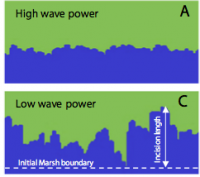Template:TEXT BOX LEFT: Difference between revisions
From CSDMS
No edit summary |
No edit summary |
||
| Line 1: | Line 1: | ||
[[Image: | [[Image:Auto Marsh.png |200px|left|link=Science_spotlights#Salt_Marshes_with_Jagged_Edges.3F]] | ||
Remember last time you stood at the muddy edge of a salt marsh? Was the edge straight, or jagged with small coves? A new cellular automata model shows that salt marsh edges evolve to be straight under high wave power regimes and to be jagged under low wave power regimes. Specifically under low wave power conditions local resistance of each cell dominates erosion rate, and this variability creates the typical small inset coves along marsh edges. Nicoletta Leonardi, contributed her marsh evolution code to further explore. [[Science_spotlights#Salt_Marshes_with_Jagged_Edges.3F|More...]]<br><br>[mailto:csdmsweb@colorado.edu Nominate a science spotlight] | |||
Revision as of 12:04, 5 October 2015
Remember last time you stood at the muddy edge of a salt marsh? Was the edge straight, or jagged with small coves? A new cellular automata model shows that salt marsh edges evolve to be straight under high wave power regimes and to be jagged under low wave power regimes. Specifically under low wave power conditions local resistance of each cell dominates erosion rate, and this variability creates the typical small inset coves along marsh edges. Nicoletta Leonardi, contributed her marsh evolution code to further explore. More...
Nominate a science spotlight

